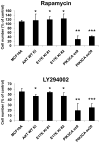Knock in of the AKT1 E17K mutation in human breast epithelial cells does not recapitulate oncogenic PIK3CA mutations
- PMID: 20101210
- PMCID: PMC3042798
- DOI: 10.1038/onc.2009.516
Knock in of the AKT1 E17K mutation in human breast epithelial cells does not recapitulate oncogenic PIK3CA mutations
Abstract
An oncogenic mutation (G49A:E17K) in the AKT1 gene has been described recently in human breast, colon, and ovarian cancers. The low frequency of this mutation and perhaps other selective pressures have prevented the isolation of human cancer cell lines that harbor this mutation thereby limiting functional analysis. Here, we create a physiologic in vitro model to study the effects of this mutation by using somatic cell gene targeting using the nontumorigenic human breast epithelial cell line, MCF10A. Surprisingly, knock in of E17K into the AKT1 gene had minimal phenotypic consequences and importantly, did not recapitulate the biochemical and growth characteristics seen with somatic cell knock in of PIK3CA hotspot mutations. These results suggest that mutations in critical genes within the PI3-kinase (PI3K) pathway are not functionally equivalent, and that other cooperative genetic events may be necessary to achieve oncogenic PI3K pathway activation in cancers that contain the AKT1 E17K mutation.
Conflict of interest statement
B.H.P. has received research funding from GlaxoSmithKline in the past, though none of the studies presented here were supported by GlaxoSmithKline. B.H.P. is also a consultant for GlaxoSmithKline and Horizon Discovery LTD. Under separate licensing agreements between Genzyme Corporation and The Johns Hopkins University, B.V. is entitled to a share of royalties received by the University on sales of products, though none described in this work. The terms of this arrangement are being managed by the Johns Hopkins University in accordance with its conflict of interest policies.
Figures





Similar articles
-
PIK3CA and AKT1 mutations have distinct effects on sensitivity to targeted pathway inhibitors in an isogenic luminal breast cancer model system.Clin Cancer Res. 2013 Oct 1;19(19):5413-22. doi: 10.1158/1078-0432.CCR-13-0884. Epub 2013 Jul 25. Clin Cancer Res. 2013. PMID: 23888070 Free PMC article.
-
AKT1(E17K) in human solid tumours.Oncogene. 2008 Sep 18;27(42):5648-50. doi: 10.1038/onc.2008.170. Epub 2008 May 26. Oncogene. 2008. PMID: 18504432
-
PIK3CA mutations and EGFR overexpression predict for lithium sensitivity in human breast epithelial cells.Cancer Biol Ther. 2011 Feb 1;11(3):358-67. doi: 10.4161/cbt.11.3.14227. Epub 2011 Feb 1. Cancer Biol Ther. 2011. PMID: 21124076 Free PMC article.
-
PIK3CA mutations in breast cancer: reconciling findings from preclinical and clinical data.Breast Cancer Res. 2014 Jan 23;16(1):201. doi: 10.1186/bcr3605. Breast Cancer Res. 2014. PMID: 25192370 Free PMC article. Review.
-
Mechanism of resistance to endocrine therapy in breast cancer: the important role of PI3K/Akt/mTOR in estrogen receptor-positive, HER2-negative breast cancer.Breast Cancer. 2018 Jul;25(4):392-401. doi: 10.1007/s12282-017-0812-x. Epub 2017 Oct 31. Breast Cancer. 2018. PMID: 29086897 Review.
Cited by
-
Targeting the PI3K/Akt/mTOR pathway for breast cancer therapy.J Mammary Gland Biol Neoplasia. 2012 Dec;17(3-4):205-16. doi: 10.1007/s10911-012-9264-2. Epub 2012 Aug 4. J Mammary Gland Biol Neoplasia. 2012. PMID: 22865098 Free PMC article. Review.
-
AKT1 E17K Inhibits Cancer Cell Migration by Abrogating β-Catenin Signaling.Mol Cancer Res. 2021 Apr;19(4):573-584. doi: 10.1158/1541-7786.MCR-20-0623. Epub 2020 Dec 10. Mol Cancer Res. 2021. PMID: 33303690 Free PMC article.
-
AKT1E17K-Interacting lncRNA SVIL-AS1 Promotes AKT1 Oncogenic Functions by Preferentially Blocking AKT1E17K Dephosphorylation.Adv Sci (Weinh). 2025 May;12(19):e2500919. doi: 10.1002/advs.202500919. Epub 2025 Mar 26. Adv Sci (Weinh). 2025. PMID: 40135844 Free PMC article.
-
The interplay between the PI3K/AKT pathway and circadian clock in physiologic and cancer-related pathologic conditions.Cell Prolif. 2024 Jul;57(7):e13608. doi: 10.1111/cpr.13608. Epub 2024 Feb 9. Cell Prolif. 2024. PMID: 38336976 Free PMC article. Review.
-
PIK3CA and AKT1 mutations have distinct effects on sensitivity to targeted pathway inhibitors in an isogenic luminal breast cancer model system.Clin Cancer Res. 2013 Oct 1;19(19):5413-22. doi: 10.1158/1078-0432.CCR-13-0884. Epub 2013 Jul 25. Clin Cancer Res. 2013. PMID: 23888070 Free PMC article.
References
-
- Abubaker J, Bavi PP, Al-Harbi S, Siraj AK, Al-Dayel F, Uddin S, Al-Kuraya K. Leukemia. 2007;21:2368–70. - PubMed
-
- Abukhdeir AM, Blair BG, Brenner K, Karakas B, Konishi H, Lim J, Sahasranaman V, Huang Y, Keen J, Davidson N, Vitolo MI, Bachman KE, Park BH. Breast Cancer Res Treat. 2006;99:23–33. - PubMed
-
- Arena S, Isella C, Martini M, de Marco A, Medico E, Bardelli A. Cancer Res. 2007a;67:8468–76. - PubMed
-
- Arena S, Isella C, Martini M, de Marco A, Medico E, Bardelli A. Cancer Res. 2007b;67:8468–8476. - PubMed
-
- Bachman KE, Argani P, Samuels Y, Silliman N, Ptak J, Szabo S, Konishi H, Karakas B, Blair BG, Lin C, Peters BA, Velculescu VE, Park BH. Cancer Biol Ther. 2004;3:772–5. - PubMed
Publication types
MeSH terms
Substances
Grants and funding
LinkOut - more resources
Full Text Sources
Other Literature Sources
Medical
Miscellaneous

